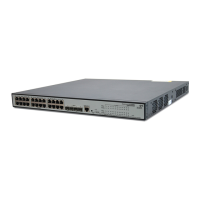184
If a path becomes faulty, the root port on this will no longer receives new configuration BPDUs and the
old configuration BPDUs will be discarded due to timeout. The device generates a configuration BPDU
with itself as the root and sends out the BPDUs and TCN BPDUs. This triggers a new spanning tree
calculation process to establish a new path to restore the network connectivity.
However, the newly calculated configuration BPDU cannot be propagated throughout the network
immediately, so the old root ports and designated ports that have not detected the topology change
continue forwarding data along the old path. If the new root ports and designated ports begin to forward
data as soon as they are elected, a temporary loop may occur.
STP timers
STP calculation involves the following timers: forward delay, hello time, and max age.
Forward delay
Forward delay is the delay time for state transition.
A path failure can cause spanning tree re-calculation to adapt the spanning tree structure to the change.
However, the resulting new configuration BPDU cannot propagate throughout the network immediately. If
the newly elected root ports and designated ports start to forward data right away, a temporary loop is
likely to occur.
For this reason, as a mechanism for state transition in STP, the newly elected root ports or designated ports
require twice the forward delay time before transiting to the forwarding state to ensure that the new
configuration BPDU has propagated throughout the network.
Hello time
The device sends hello packets at the hello time interval to the neighboring devices to ensure that the paths
are fault-free.
Max age
The device uses the max age to determine whether a stored configuration BPDU has expired and discards
it if the max age is exceeded.
RSTP
RSTP achieves rapid network convergence by allowing a newly elected root port or designated port to enter
the forwarding state much faster under certain conditions than STP.
A newly elected RSTP root port rapidly enters the forwarding state if the old root port on the device has
stopped forwarding data and the upstream designated port has started forwarding data.
A newly elected RSTP designated port rapidly enters the forwarding state if it is an edge port (which directly
connects to a user terminal rather than to another network device or a shared LAN segment) or it connects
to a point-to-point link (to another device). Edge ports directly enter the forwarding state. Connecting to a
point-to-point link, a designated port enters the forwarding state immediately after the device receives a
handshake response from the directly connected device.

